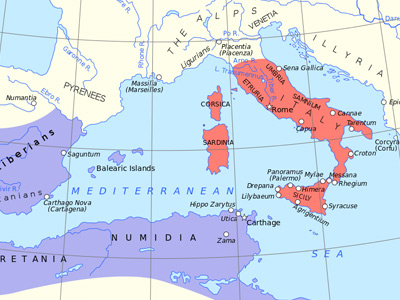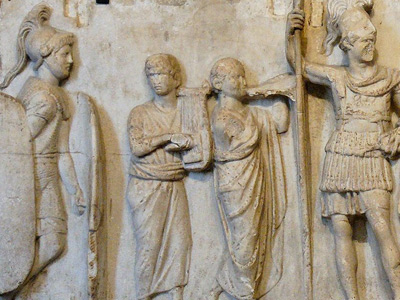Second Punic War (218-201 BC)

Second Roman Expedition to Iberia
In 210 BC, Scipio Africanus arrived in Iberia on the Senate's orders to avenge his father and uncle.
In a brilliant Roman The Roman Republic was a form of government of Rome and the era of the classical Roman civilization when it was run through public representation of the Roman people. Beginning with the overthrow of the Roman Kingdom (traditionally dated to 509 BC) and ending in 27 BC with the establishment of the Roman Empire, Rome's control rapidly expanded during this period - from the city's immediate surroundings to hegemony over the entire Mediterranean world. assault in 209 BC, Scipio succeeded in capturing Cartago Nova, which was the centre of Carthagenian power in Iberia. He defeated Hasdrubal in the Battle of Baecula (208 BC), but was not able to prevent him from continuing his march to Italy in order to reinforce his brother Hannibal
The Roman Republic was a form of government of Rome and the era of the classical Roman civilization when it was run through public representation of the Roman people. Beginning with the overthrow of the Roman Kingdom (traditionally dated to 509 BC) and ending in 27 BC with the establishment of the Roman Empire, Rome's control rapidly expanded during this period - from the city's immediate surroundings to hegemony over the entire Mediterranean world. assault in 209 BC, Scipio succeeded in capturing Cartago Nova, which was the centre of Carthagenian power in Iberia. He defeated Hasdrubal in the Battle of Baecula (208 BC), but was not able to prevent him from continuing his march to Italy in order to reinforce his brother Hannibal Hannibal Barca (247-183 BC), was a Carthaginian general, considered one of the greatest military commanders in history. Hannibal lived during a period of great tension in the western Mediterranean Basin, when the Roman Republic established its supremacy over other great powers such as ancient Carthage. One of his most famous achievements was at the outbreak of the Second Punic War, when he marched an army which included war elephants from Iberia over the Pyrenees and the Alps into Italy. Hannibal Barca ».
Hannibal Barca (247-183 BC), was a Carthaginian general, considered one of the greatest military commanders in history. Hannibal lived during a period of great tension in the western Mediterranean Basin, when the Roman Republic established its supremacy over other great powers such as ancient Carthage. One of his most famous achievements was at the outbreak of the Second Punic War, when he marched an army which included war elephants from Iberia over the Pyrenees and the Alps into Italy. Hannibal Barca ».
In the Battle of Ilipa (206 BC), Scipio defeated a combined army under the command of Mago Barca, Hasdrubal Gisgo and Masinissa, thus bringing to an end the Carthaginian hold in Iberia.
Related Articles
First Punic War (264-241 BC)
The first of three wars fought between Ancient Carthage and the Roman Republic. For more than 20 years, the two powers struggled for supremacy, primarily on the Mediterranean island of Sicily and its surrounding waters, and also in North Africa. View First Punic War (264-241 BC) »
Second Punic War (218-201 BC)
The Second Punic War, also referred to as The Hannibalic War and (by the Romans) the War Against Hannibal, lasted from 218 to 201 BC and involved combatants in the western and eastern Mediterranean. View Second Punic War (218-201 BC) »
Third Punic War (149–146 BC)
Was the third and last of the Punic Wars fought between the former Phoenician colony of Carthage and the Roman Republic. This war was a much smaller engagement than the two previous Punic Wars and focused on Tunisia. View Third Punic War (149–146 BC) »
HISTORY

RESOURCES
This article uses material from the Wikipedia article "Second Punic War", which is released under the Creative Commons Attribution-Share-Alike License 3.0.
© Stories Preschool. All Rights Reserved.













